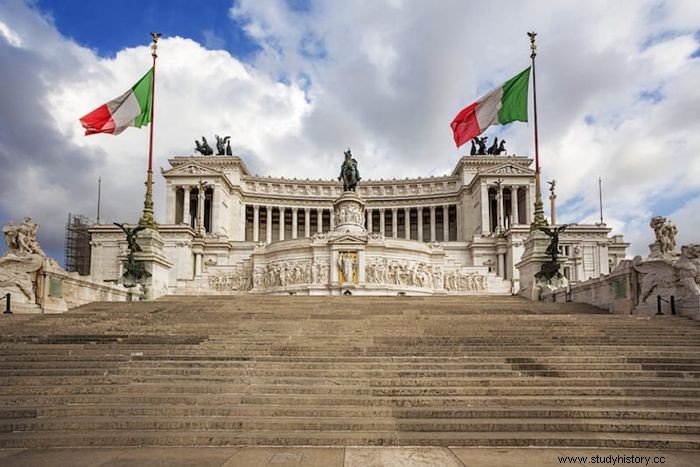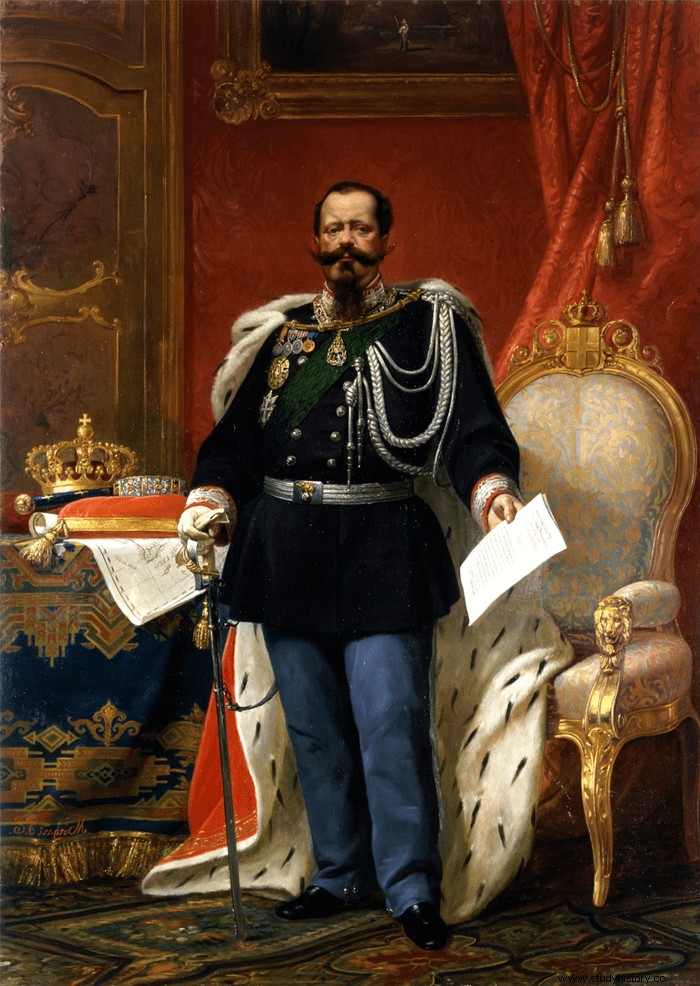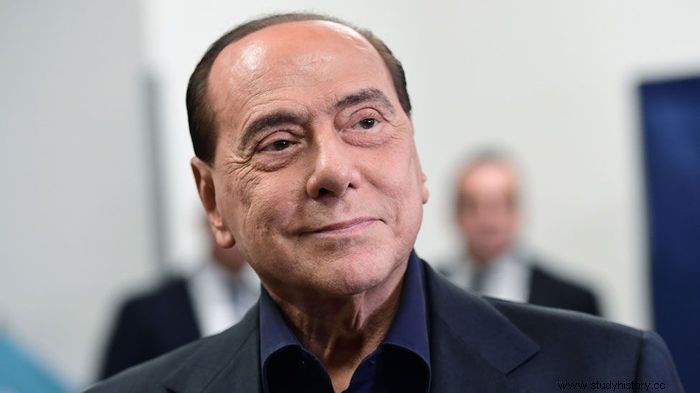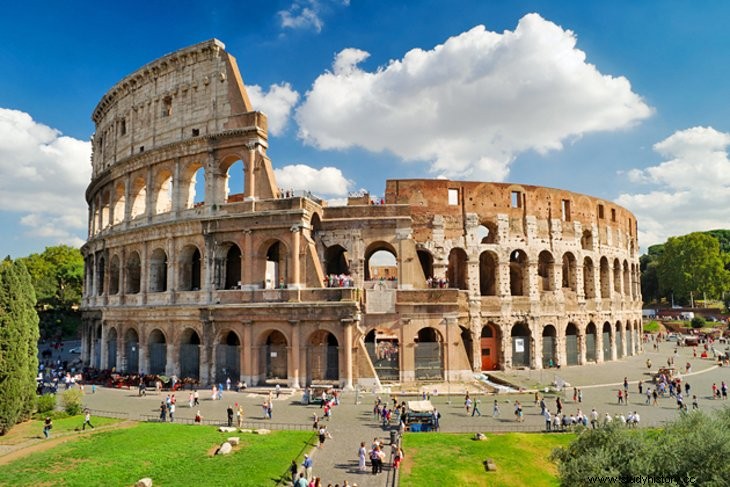The history of the Italian Republic relates to events in Italian history that occurred since 1946, when Italy became a republic. As a result, the history of the Italian Republic is divided into two periods, known as the First and Second Republics.
History of the Italian Republic
From 1946 to 1994, with the fall of the fascist state in Italy and World War II, Christian Democracy (DC), a broad-based Christian political party, dominated Italian politics and society. The Italian Communist Party led the opposition from the late 1940s to 1991. (PCI).
During this time, Christian democracy ruled without interruption, ruled every cabinet, and supplied virtually every prime minister. In addition, it ruled largely with the support of small parties ranging from center-left to center-right, including the Italian Socialist Party (PSI), the Italian Democratic Socialist Party (PSDI), the Italian Republican Party (PRI), and the Italian Liberal Party. (PLI). Apart from the short-lived historic compromise, in which the PCI offered external support to a DC minority administration from 1976 to 1979, the Communist Party stayed away from the government.

Political resolution
The political climate changed drastically in the early 1990s due to two significant shocks:the fall of the Soviet Union in 1991 and the Tangentopoli corruption scandal, which lasted from 1992 to 1994.
The first resulted in the dissolution and fragmentation of PCI and the fragmentation of the opposition. Nevertheless, the latter resulted in the abolition of virtually all established political parties in Italy, including the Christian Democrats, the PSI, the PSDI, the PRI, the PLI and others. The anti-establishment rage led to a referendum in 1993, which allowed the electoral system to change from a purely proportional representation to a majority-leaning hybrid system.
Silvio Berlusconi, the media magnate, joined the politics of his conservative Forza Italia party and won the parliamentary elections in 1994, creating the Berlusconi I cabinet. Over the next two decades, he rose to become one of Italy's most powerful individuals, serving as Prime Minister from 2001 to 2006 and again from 2008 to 2011.
With the development of the new Conservative right, the traditional center and left merged to form the Olive Tree coalition, which included the post-communist left-wing Democrats and the Christian Democrat The Daisy, which formed the Democratic Party (PD) in 2007. They opposed Berlusconi's center-right. coalition, including Forza Italia, the right-wing National Alliance and the Northern League, a regionalist party from the northern Italian republic.
After Berlusconi's fourth administration fell apart in 2011, the technocratic Monti cabinet was formed, which lasted until 2013. Due to persistent dissatisfaction, the populist Five Star Movement (M5S) and Northern League became prominent (renamed the League, Lega). After the Italian parliamentary elections in 2013 and again in 2018, large coalition governments were formed with the support of populist parties. The terrible economic and epidemic disaster with COVID-19 draws former European Central Bank President Mario Draghi to the cabinet of national unity.
centuries before
In the eighth century BCE, the Greeks were the first advanced culture to settle in Italy. They established colonies throughout the southern Italian coast and on the island of Sicily. The Phoenicians wanted to do the same afterwards. A small agricultural settlement grew on the west coast of Italy in the same period, in the 8th century BC. It established Rome, which became one of the world's largest civilizations, ancient Rome. See Ancient Rome for children for more information. Rome was to establish the Roman Republic first, followed by the Roman Empire.
Its dominance will extend over most of Europe and the Mediterranean. Along with Greek culture, Rome would have a significant impact on the formation of much of today's Western civilization, including philosophy, art, and law. The Roman Empire was divided into two halves in 395 AD:the Western Roman Empire and the Eastern Roman Empire. Italy was a member of the Western Empire, which fell apart around 476 AD. Italy wanted many smaller city-states in the following many hundreds of years. Forum of the Romans Italy became the home of the Italian Renaissance in the 15th century. During this time, artists like Leonardo da Vinci and Michelangelo thrived.
Much of Italy wanted to unite into a single country in the 19th century. Instead, Italy became a constitutional monarchy and an independent, undivided country in 1871.

A chronology of key events
- Italy became a nation-state under King Victor Emmanuel II in 1861.
- 1915 - Italy joins the Allies in World War I. 1919 - As part of post-war peace treaties, Italy takes over Trentino, South Tyrol and Trieste from Austria-Hungary.
- After three years of political and economic instability, the fascist leader Benito Mussolini gained authority and introduced an authoritarian regime in 1922.
- Italy invaded Ethiopia in 1935.
- Benito Mussolini agreed with Nazi Germany in 1936.
- Albania annexation in 1939. 1940 - Italy joins World War II on the German side. In East Africa, Italian soldiers occupy British Somaliland.
- The Allies attacked Sicily in 1943. Benito Mussolini was deposed, and a truce was reached with the Allies. Then, however, Germany declares war on Italy. 1945 - Benito Mussolini is captured and killed by Italian partisans after being released from prison by Germans.
History of the Italian Republic (The Road to European Integration)
- 1946 - A referendum is held to decide whether a republic should replace the monarchy.
- Under the terms of the peace agreement, Italy cedes territory and regions. 1948:A new constitution! The Christian Democrats win elections.
- Italy joined the European Coal and Steel Community in 1951.
- 1957 - Became a founding member of the European Economic Community. Giliio Andreotti became Prime Minister in 1972, a position he will hold seven times over the next 20 years. 1976-78 - Communist election victories give them a say in policy-making.
- Former Prime Minister Aldo Moro is kidnapped and assassinated by the Red Brigades, a left-wing armed organization. Abortion is now legal.
- The bombing of Bologna railway station in 1980 killed 84 people related to right-wing militants.
- Bettino Craxi became Italy's first socialist prime minister in 1983. 1984:Roman Catholicism is the state religion.
- Communists called themselves the Liberal Democratic Party in 1991.
History of the Italian Republic
- Corruption Investigation
- 1992 - High-level corruption revelations fuel many years of arrests and investigations.
- Giovanni Falcone, a top anti-mafia prosecutor, his wife and three bodyguards died in a bomb attack. 1993 - Craxi resigns as leader of the Socialist Party over a bribery controversy. He eventually escapes the country, is sentenced and sentenced to prison in absentia, and dies in Tunisia in 2000.
- In March 1994, the Freedom Alliance was elected. However, after confrontations with anti-corruption judges and a struggle with unions over pension reform, the coalition consists of Silvio Berlusconi's Forza Italia, Northern League, and the neo-fascist national alliance falls before the end of the year. Lamberto Dini led a technocratic administration in 1995-96. Budget tightening.
- The center-left Olive Real Alliance won the election in 1996. As a result, Romano Prodi was appointed Prime Minister.
- Earthquake destroyed the Umbria area in 1997, causing extensive damage to the Basilica of St. Francis of Assisi. Four people died.
- Berlusconi returns
- 2001 May / June - The Storting election is won by a center-right coalition led by Silvio Berlusconi from the Forza Italia party.
- Berlusconi forms a new coalition government with the leaders of two right-wing parties, the National Alliance's Gianfranco Fini, the Northern League's Umberto Bossi and the pro-European Union's Renato Ruggiero, who will be foreign minister.
- 2001 October - In the country's first constitutional referendum since 1946, voters approve a key revision that gives greater autonomy to the country's 20 regions in tax, education and environmental policy.
- The euro replaced the lira in January 2002.
- In court, Berlusconi.
History of the Italian Republic
- In November 2003, a multi-billion euro fraud was discovered by the food conglomerate Parmalat. As a result, the company went bankrupt.
- In January 2004, the Constitutional Court repealed a provision giving Berlusconi and other top government officials protection against prosecution. As a result, Berlusconi's trial will begin in April and he will be acquitted in December.
- Parliament ratified the EU Constitution in April 2005.
- Prodi comes in, so go.
- Romano Prodi, the center-left leader, won a major election in April 2006.
- Police arrested Italy's most wanted man and charged Sicilian mafia boss Bernardo Provenzano.
- 2006 June - A national referendum rejects measures to increase the authority of the prime minister and the regions. During Silvio Berlusconi's presidency, he proposed modifications.
- Hundreds of Italian troops left for Lebanon in August 2006. As a result, Italy is on track to become the military's largest donor to the UN-mandated force.
- A vote of no confidence led to the resignation of Prodi's cabinet in January 2008.
- Berlusconi has returned.
- Berlusconi won the parliamentary elections in April 2008, and won a third term as prime minister after two years in opposition.
- 2008. November - Italy is officially considered to be in recession after two consecutive quarters of negative growth.

History of the Italian Republic
- Earthquake hit cities in the hilly Abruzzo area in April 2009, killing hundreds and displacing thousands.
- In October 2009, the Constitutional Court amended a law that gave Prime Minister Berlusconi protection while in office.
- Coalition schism Mr Berlusconi's coalition lost a majority in Parliament's lower house in August 2010 when more than 30 lawmakers left his People of Freedom party.
- A court in Milan has ordered Berlusconi to stand trial in April for allegations of abuse of authority and payment for sex with a minor prostitute. September 2011:Parliament receives final approval of a € 54 billion austerity plan (£ 47 billion; $ 74 billion). The plan includes a commitment to balance the budget by 2013.
- Berlusconi is retiring
- November 2011 - Mr Berlusconi resigns as Italy's debt burden grows after his government failed to gain an absolute majority in the Chamber of Deputies during a budget vote. Former EU Commissioner Mario Monti has formed a technocratic administration.
- Parliament approved Monti's € 33 billion savings plan (£ 27 billion; $ 43 billion) in budget cuts in December 2011. Measures to raise taxes and combat tax evasion are also included in the package.
- January 2012 - The government publishes a deregulation order to prevent restrictive behavior, minimize protectionism and promote competition.
- Berlusconi was found guilty. Silvio Berlusconi was sentenced to one year in prison in March 2013 for illegal wiretapping. However, he is still at large pending the outcome of the appeal process.
- After Pier Luigi Bersani resigns as PD leader, Enrico Letta of the Democratic Party (PD) becomes prime minister, leading a major coalition including Silvio Berlusconi's PdL.
- Berlusconi's convictions confirmed (History of the Italian Republic)
Timeline of the Italian Republic
- August 2013 - Italy's Supreme Court upholds Silvio Berlusconi's conviction for tax evasion in October 2012, marking the former prime minister's first conviction. Due to his age, he is sentenced to community service instead of imprisonment and is barred from holding public office for two years.
- October 2013 - The governor of Sicily declares a state of emergency after hundreds of migrants died in shipwrecks while trying to enter Europe from Africa.
- In November 2013, the Senate expelled Berlusconi from parliament for his tax evasion conviction and deprived him of immunity from arrest.
- Matteo Renzi, the leader and mayor of the new Democratic Party in Florence, created a new left-right coalition government and unveiled proposals for massive economic and political transformation in February 2014.
- Former Prime Minister Silvio Berlusconi wins appeal against his June 2013 conviction for paying for sex with a minor prostitute. 14. August 2014 - The Senate, or the upper house of parliament, votes to support Prime Minister Renzi's plans to dramatically reduce the size and authority of the chamber.
- May 2015 - Parliament approves an election change that gives the largest party an automatic majority of seats in parliament.
- August 2016 - An earthquake shocks central Italy's hilly Apennine region, causing extensive damage and death.
- Renzi offered his resignation as Prime Minister in November 2016 when his central constitutional reform program lost in a referendum. Paolo Gentiloni, a supporter of the Democratic Party, succeeds him.
- 2017 July - EU regulators accept a public rescue of Monte Dei Paschi, the world's oldest bank. It was at the heart of Italy's financial crisis.
- In non-binding referendums, Veneto and Lombardy, two rich northern regions, are strongly in favor of increased autonomy.
- The rise of populists
History Timeline of the Italian Republic
- June 2018 - Following the March elections, Western Europe's first populist coalition government takes power, with plans to cut taxes, increase social spending and change EU finances and immigration laws.
- December 2018 - Due to EU concerns, the government's budget expenditure forecasts must be scaled down.
- January 2019 - Data indicates that the economy entered a recession in the fourth quarter of 2018.
- 2019 August - Matteo Salvini, the leader of the right-wing League Party, resigns from the cabinet to speed up early elections. However, the radical 5-star movement and the Democratic Party from the center and left have agreed to form a new government without the league, with law professor Giuseppe Conte as still prime minister.
- In Emilia-Romagna, the League Party will not be able to oust the left in a central election in January 2020.
- 2021 February - Mario Draghi, an economist and former Bank of Italy chief, creates a national unity government to pull Italy out of the COVID pandemic crisis. Due to the severity of the crises, President Mattarella appointed a new prime minister to a grand coalition government, former European Central Bank President Mario Draghi, who headed a cabinet with the support of all political parties in parliament except the right-wing party. Fratelli d'Italia.
- Vaccination efforts against the COVID-19 pandemic accelerated due to a significant supply of vaccine doses (85% of the population over 12 years of age vaccinated at the end of December 2021). In addition, the National Recovery and Resilience Plan (PNRR) was formed. It is a document outlining Italy's intended use of next-generation EU funding and loans.

the conclusion
The Italian Republic in the twenty-first century was considerably richer and more developed than it had been a century before. However, many problems, including ongoing political insecurity and corruption, persisted, historical but lasting economic and cultural divides between North and South. New difficulties arose as a result of immigration and European economic and political union. These questions dominated Italy's political and economic agenda at the beginning of the twenty-first century.
